Exploring the Best Kitchen Flooring Options
In our technologically interconnected world, the importance of electronics can’t be overstated. They serve as our primary tools for communication, information gathering, entertainment, and so much more. However, like any other commodity, they can fall prey to unfortunate circumstances, including accidents, disasters, and the simple toll of time. This vulnerability poses the question: how do we maintain their longevity and effectiveness?
The answer lies in understanding and embracing electronics restoration. It’s a service that breathes new life into our prized devices, safeguarding our investment and conserving the environment by reducing electronic waste. In this process, both businesses and homeowners find an advantageous solution for extending the lifespan of their valuable electronic assets, be it data-laden computers in an office setup or much-loved appliances in a home. Moreover, in the aftermath of a disaster, restoration emerges as a beacon of hope for reclaiming some semblance of normalcy, initiating a recovery journey that is as technical as it is emotional.
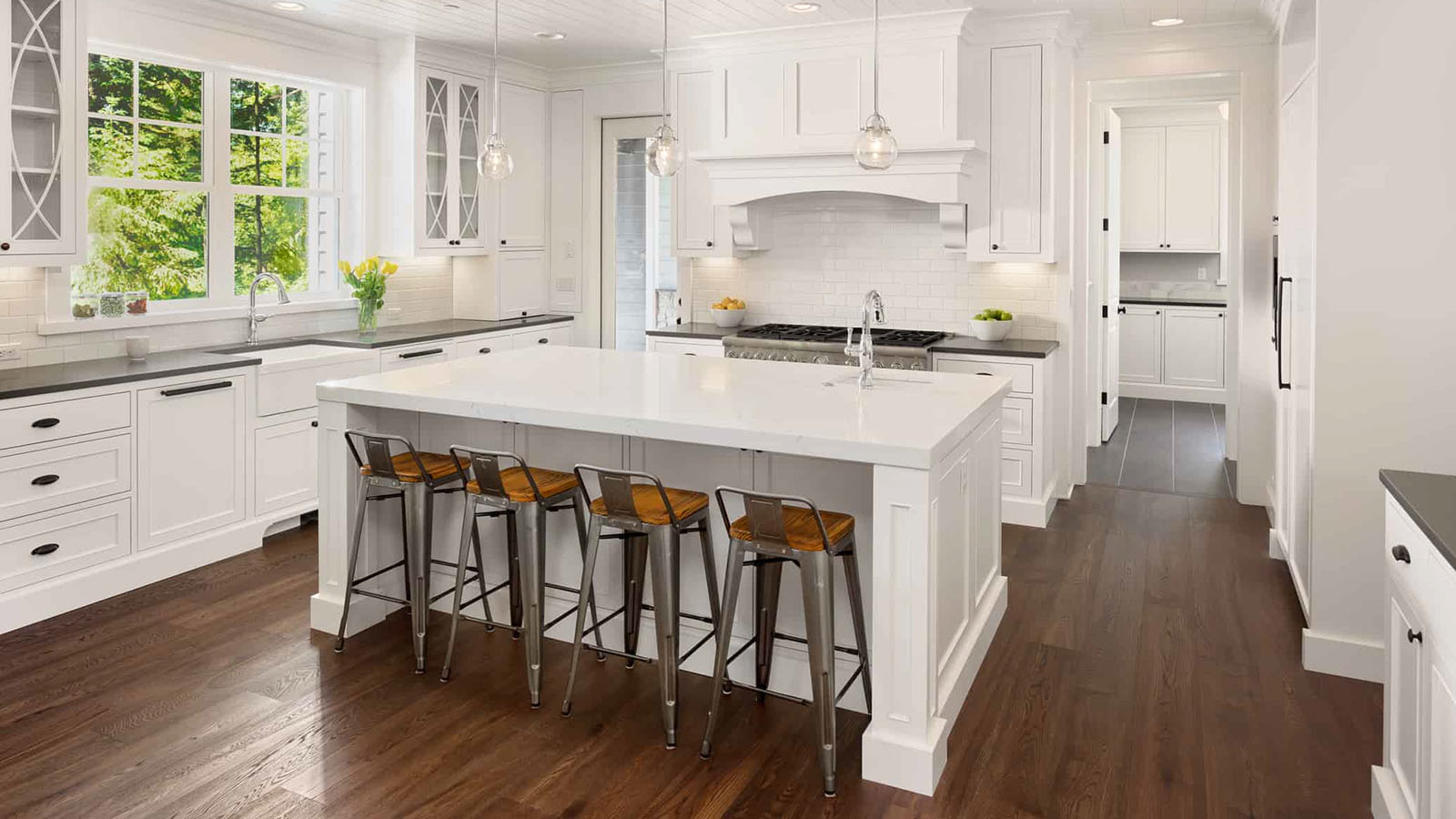
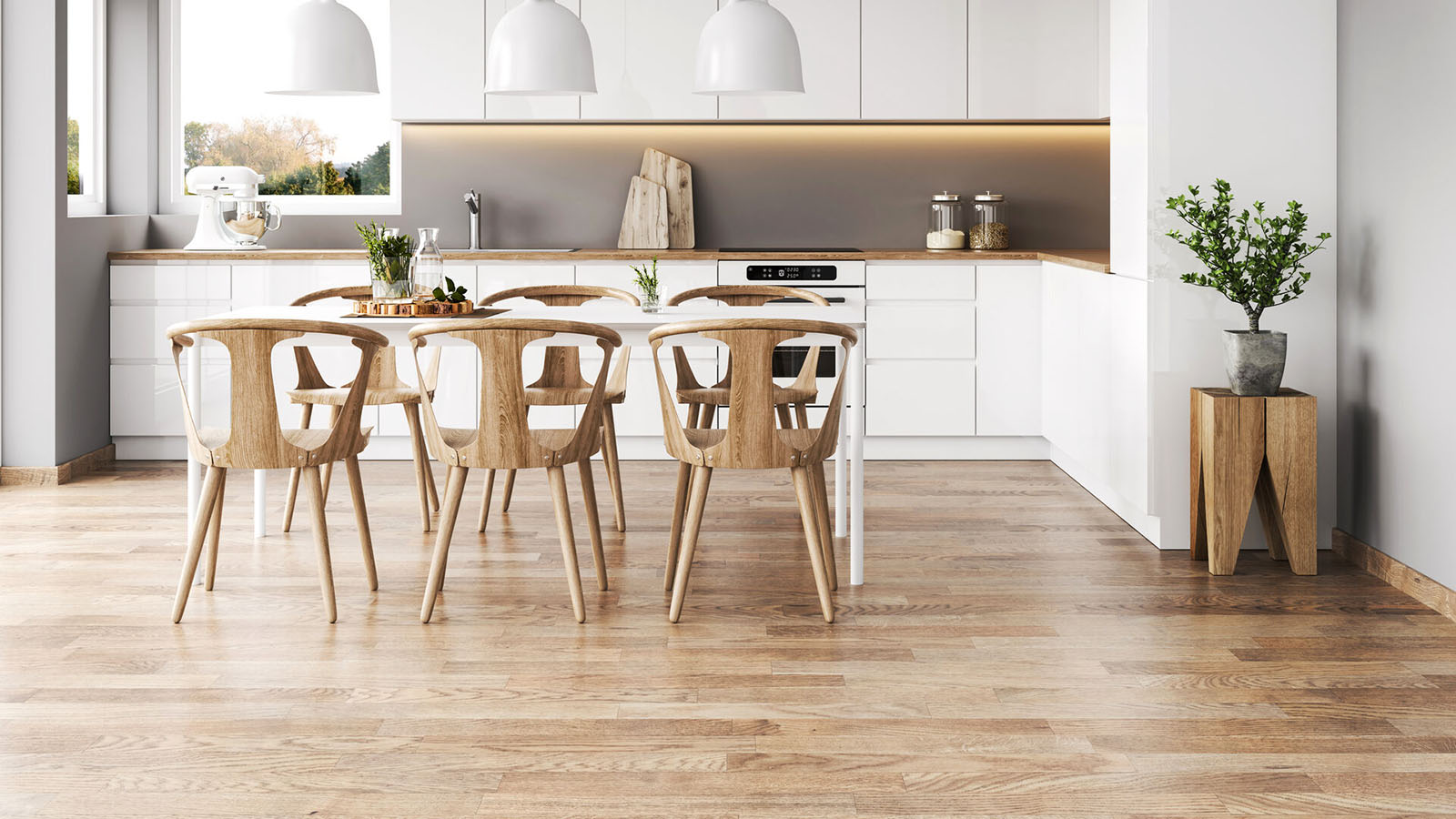
Types of Kitchen Flooring Options
Selecting the best flooring for your kitchen depends on various factors, including style, budget and kitchen use. There are a multitude of flooring options available, each with its own unique pros and cons. To make an informed decision, it’s important to understand these differences. Some people prioritize durability and ease of maintenance, while others might place more importance on the aesthetic appeal of the flooring. Furthermore, your choice might be influenced by other factors such as environmental sustainability and comfort underfoot.
Hardwood Flooring
Hardwood flooring provides a warm, timeless appeal to any kitchen. It is durable and able to withstand significant wear and tear. However, hardwood flooring can be expensive and requires consistent maintenance to keep it looking its best. Additionally, it can be susceptible to water damage if not properly sealed. Despite these factors, the natural beauty of hardwood floors makes them a popular choice for many homeowners.
Vinyl Flooring
Vinyl flooring, including vinyl planks and luxury vinyl tiles, is versatile and budget-friendly. This type of flooring is known for its durability and resilience. It’s water resistant, easy to clean and comes in various styles that can mimic the look of wood or stone. However, vinyl flooring can be prone to denting and may not add as much value to your home compared to other flooring types.
Ceramic and Porcelain Tiles
Ceramic and porcelain offer a wide range of design possibilities. They are known for their durability and can withstand heavy traffic. However, they can be cold and hard underfoot. Additionally, grout lines require regular cleaning to prevent staining. Despite this, their various styles and colors make them popular with many homeowners.
Cork Flooring
Cork flooring, made from ground-up cork, is a sustainable and comfortable option. It’s easy on the feet and has a unique, warm look. However, it can fade in direct sunlight and may not be as durable as other flooring options. Despite these factors, its environmental sustainability and comfort make it an appealing choice for some homeowners.
Bamboo and Laminate Flooring
Bamboo flooring, made from pulped bamboo, is another sustainable and durable option. Laminate, which comes in various designs, is also durable and can be a more affordable alternative to hardwood. However, these materials are not as water-resistant as other options, making them less ideal for kitchens with high moisture levels or frequent spills. However, their durability, style and affordability can make them a viable option for some homeowners.
Natural Stone Tiles
Natural stone tiles, including granite, marble and slate, offer a luxurious, timeless aesthetic. They’re durable and can withstand heavy traffic but require regular sealing to prevent stains and damage. These tiles can be expensive, but natural stone tiles’ high-end look and longevity are worth the investment for many homeowners.
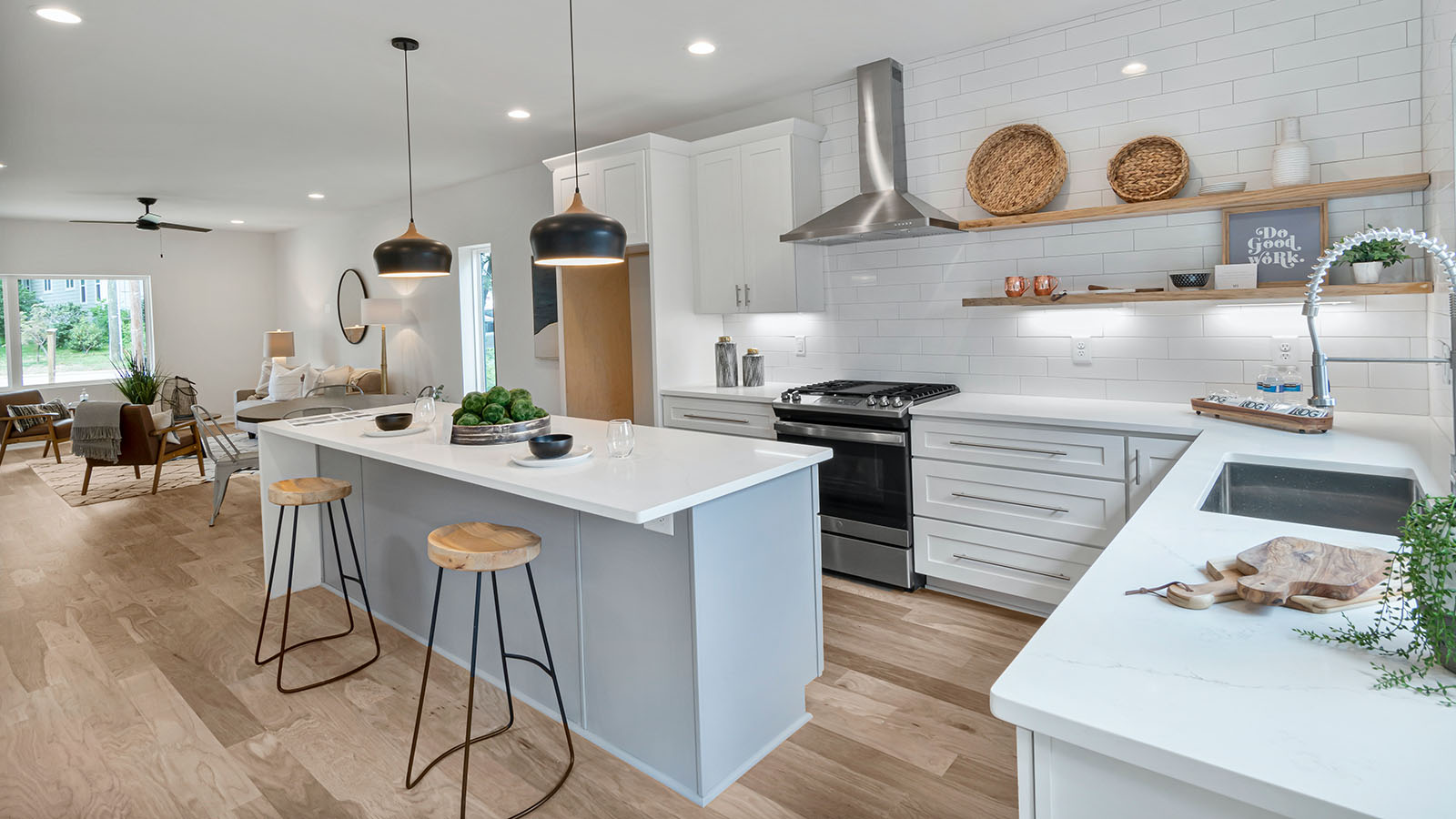
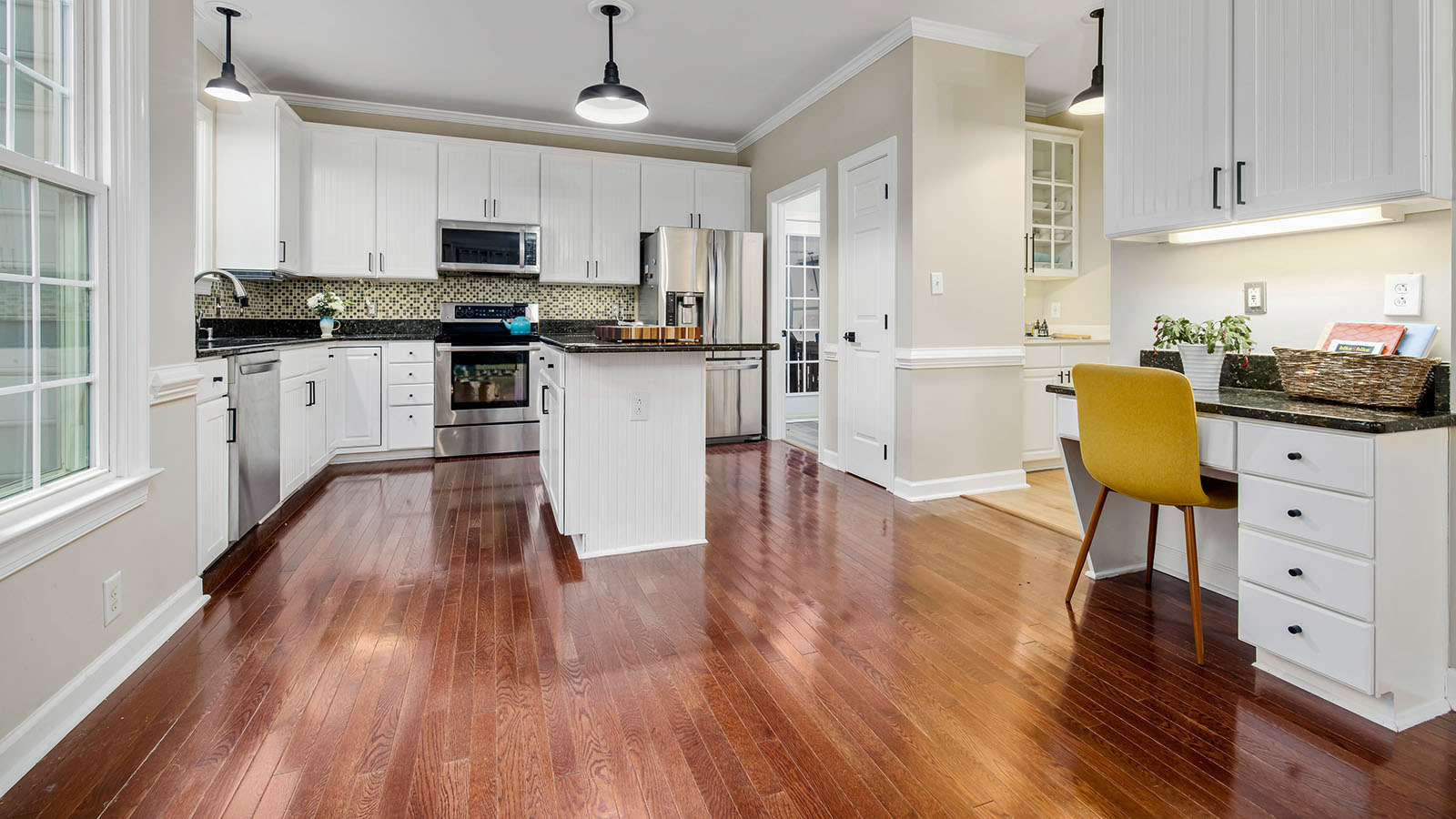
Comfort, Mobility and Durability in Kitchen Flooring
As you consider your kitchen flooring options, comfort and mobility are two essential aspects that shouldn’t be overlooked. The kitchen often serves as the heart of the home, a space where you and your family spend a significant amount of time cooking, socializing and making memories. Therefore, selecting a flooring material that provides a comfortable surface underfoot is paramount, particularly for those extended cooking or baking sessions.
But comfort isn’t the only consideration. With kitchens being high-traffic areas, it’s equally important to choose a flooring option that caters to the safety and mobility needs of every member of your household, including the elderly, young children or those with physical disabilities. The ideal flooring material should offer a safe, stable and non-slip surface to prevent accidents while being easy to traverse for those with mobility aids. Balancing comfort, safety and mobility in your kitchen flooring decisions will ensure a welcoming and inclusive space for everyone in your home.
Comfortable Flooring Options
Cork and vinyl flooring are two of the most comfortable flooring materials underfoot. Cork has a natural springiness that can ease the joint strain, while vinyl often has a bit of give that can be easier on your feet than harder materials like stone or tile.
Flooring for Mobility Issues
Smooth, stable flooring is best for those with mobility issues. Hardwood and vinyl flooring are good options, as they offer smooth, even surfaces. Textured or rough surfaces, like some natural stone or tile, can pose a tripping hazard.
Most Durable Kitchen Flooring
When it comes to durability, porcelain tile is one of the toughest kitchen flooring materials. It’s resistant to scratches and stains and can withstand high levels of foot traffic. Stone and hardwood are also very durable, although they may require more maintenance to keep them looking their best.
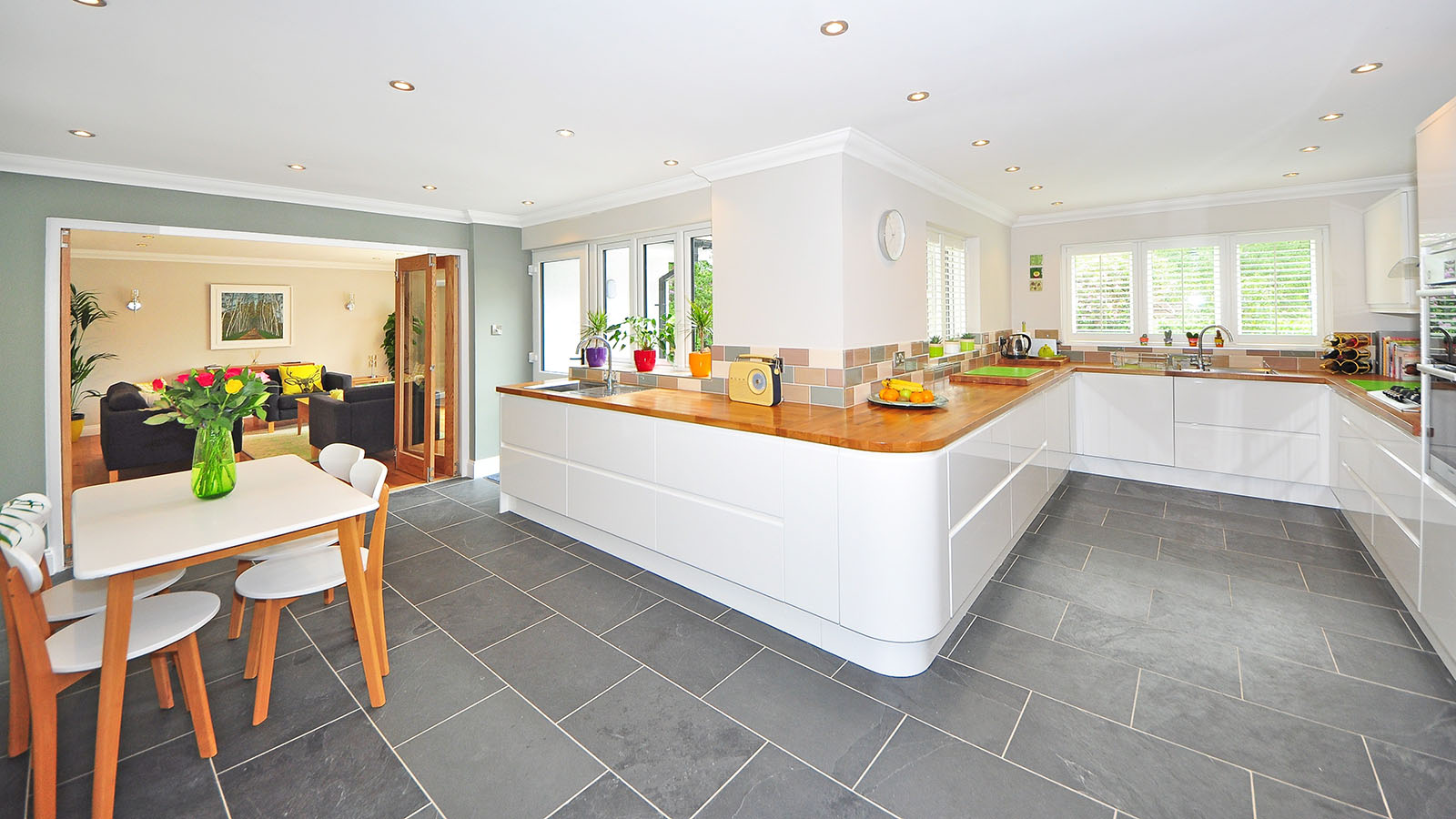

Exploring Timeless Kitchen Flooring Choices
In the home renovation and remodeling world, longevity is key, especially when it comes to the design elements of your kitchen. Opting for a timeless flooring choice can ensure your kitchen retains its appeal and positively impact your home’s resale value. By selecting a professional flooring installation that transcends fleeting trends, you create a space that continues to resonate with timeless elegance, regardless of changing design fads.
Certain flooring materials, such as hardwood, natural stone and ceramic tiles, have proven their staying power throughout the decades. These options offer classic aesthetics that blend effortlessly with a myriad of kitchen styles, from traditional to contemporary, rustic to modern. Investing in a timeless and durable flooring choice is a strategic way to ensure your kitchen retains its charm and function, standing up against the passage of time and changing fashion trends.
Hardwood Flooring
Hardwood flooring has long been considered a timeless choice for any kitchen. Its warm, natural look can complement almost any style of decor. While trends may come and go, the beauty of hardwood flooring remains constant.
Natural Stone Flooring
Stone is another enduring selection in the realm of timeless flooring. With its ability to age gracefully, just like hardwood, it offers long-lasting durability that can span generations, provided it receives proper care. Additionally, each piece of natural stone tile boasts unique variations in pattern and color, assuring a one-of-a-kind aesthetic for every kitchen it graces.
Ceramic Tile Flooring
Ceramic tile holds its place as a traditional favorite, fitting seamlessly into classic or rustic kitchen decor. The broad array of available colors, shapes and designs ensures ceramic tiles deliver an enduring charm, effortlessly adapting to changing styles. Simultaneously, these tiles uphold high durability, standing up to the demands of a bustling kitchen environment.
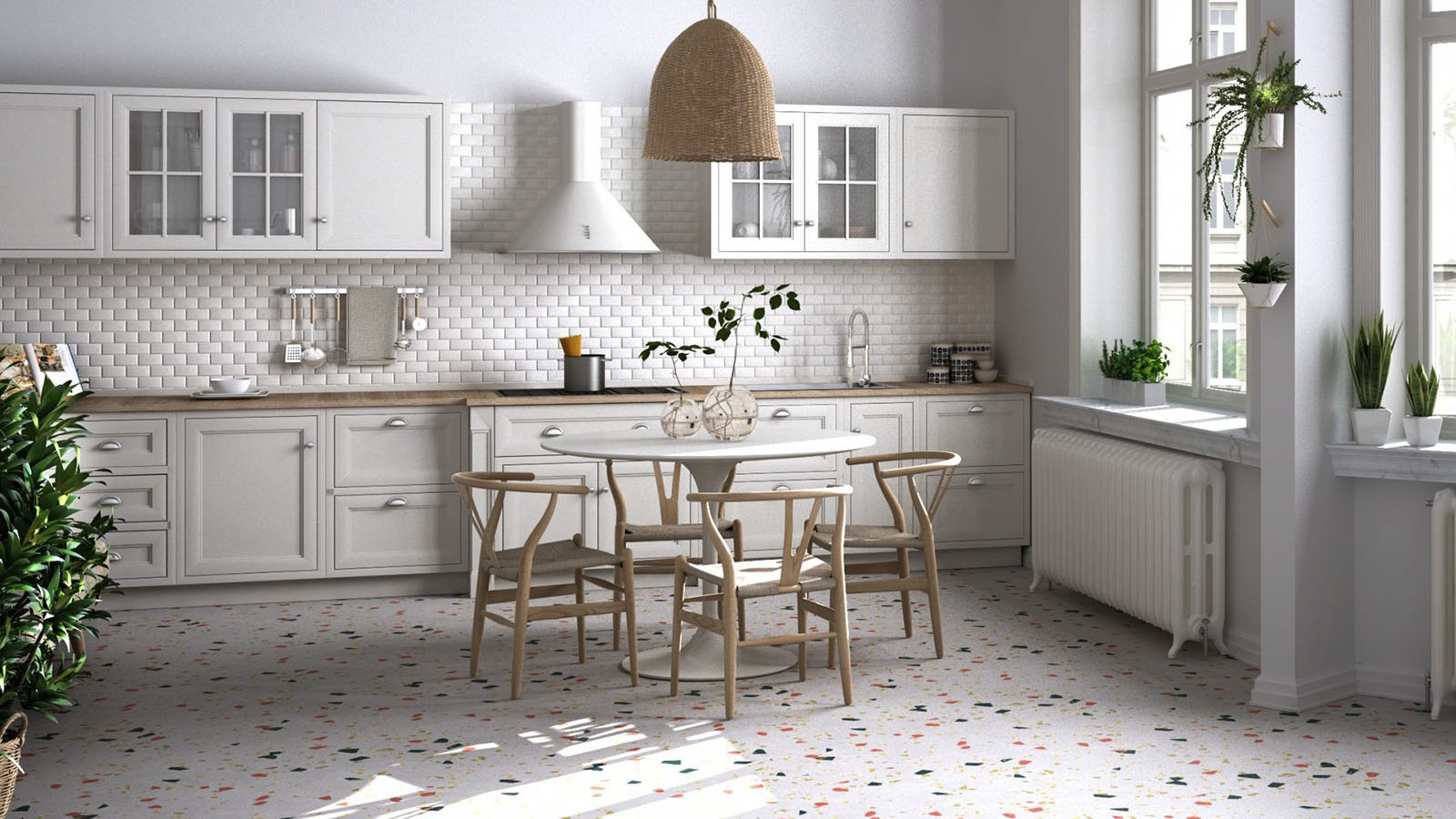

Cost Analysis of Kitchen Flooring
The cost of flooring can vary widely depending on the material, the size of your kitchen and whether you choose to install it yourself or hire a professional. It’s important to consider not just the initial cost of the flooring material but also the long-term maintenance costs, as some materials require more upkeep than others.
Hardwood and Natural Stone Flooring
Hardwood and stone flooring are often more expensive up front, ranging from $5 to $15 per square foot for hardwood and $10 to $20 for natural stone. This does not include installation costs, which can add a significant amount to your total budget. However, their longevity and the value they add to your home can make them worth the investment.
Vinyl and Laminate Flooring
Vinyl and laminate are typically less expensive, ranging from $1 to $5 per square foot. They are also easier to install, which can save on labor costs. These materials can be cost-effective for homeowners on a tighter budget or those who prefer to change their flooring more frequently.
Ceramic and Porcelain Tiles
Ceramic and porcelain can range from $2 to $10 per square foot, depending on the quality and design of the tiles. Installation of kitchen floor tiles can be more labor-intensive than other flooring types, which could increase the overall cost. Despite this, their durability and versatility can make them a worthwhile investment.
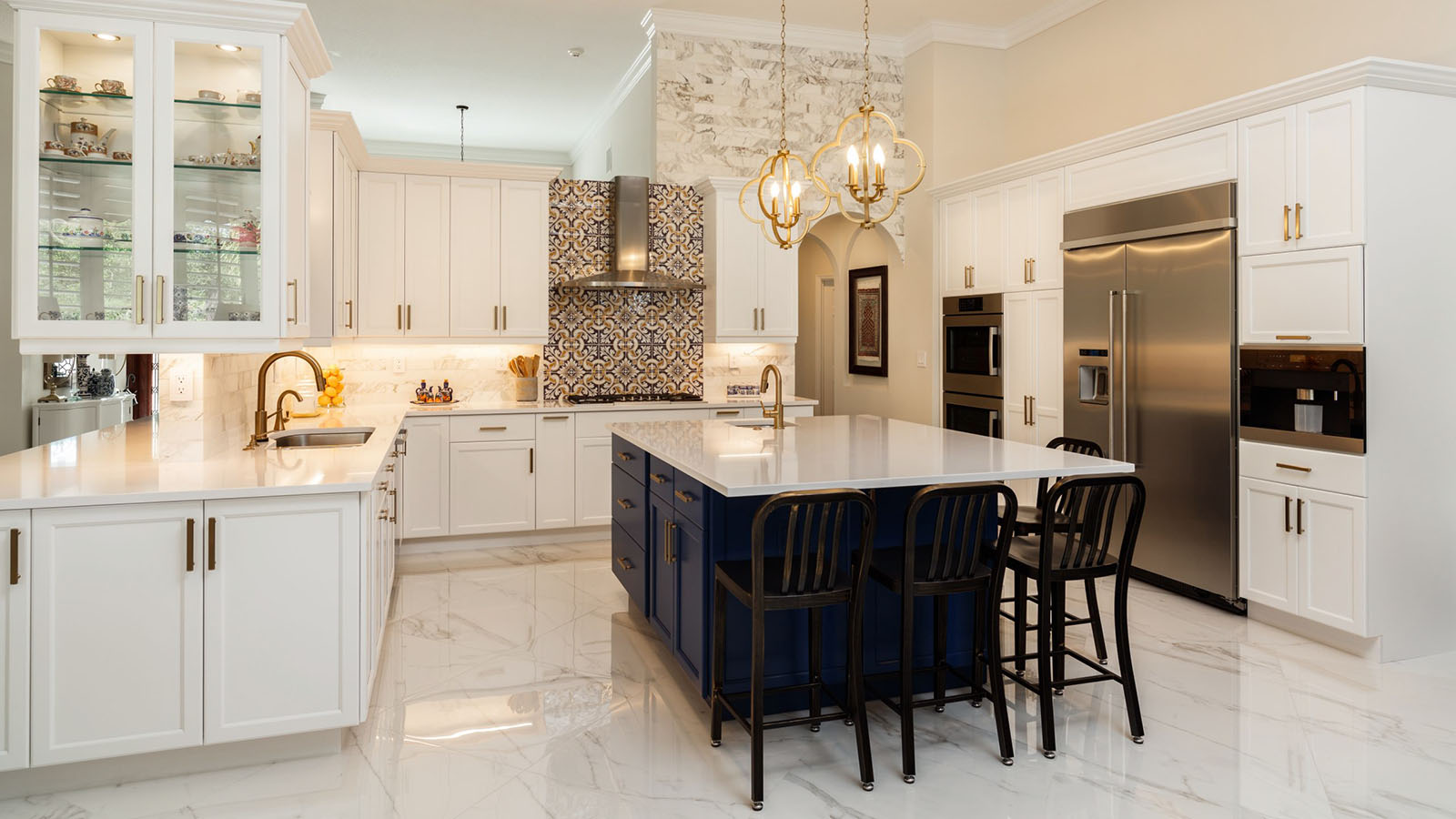
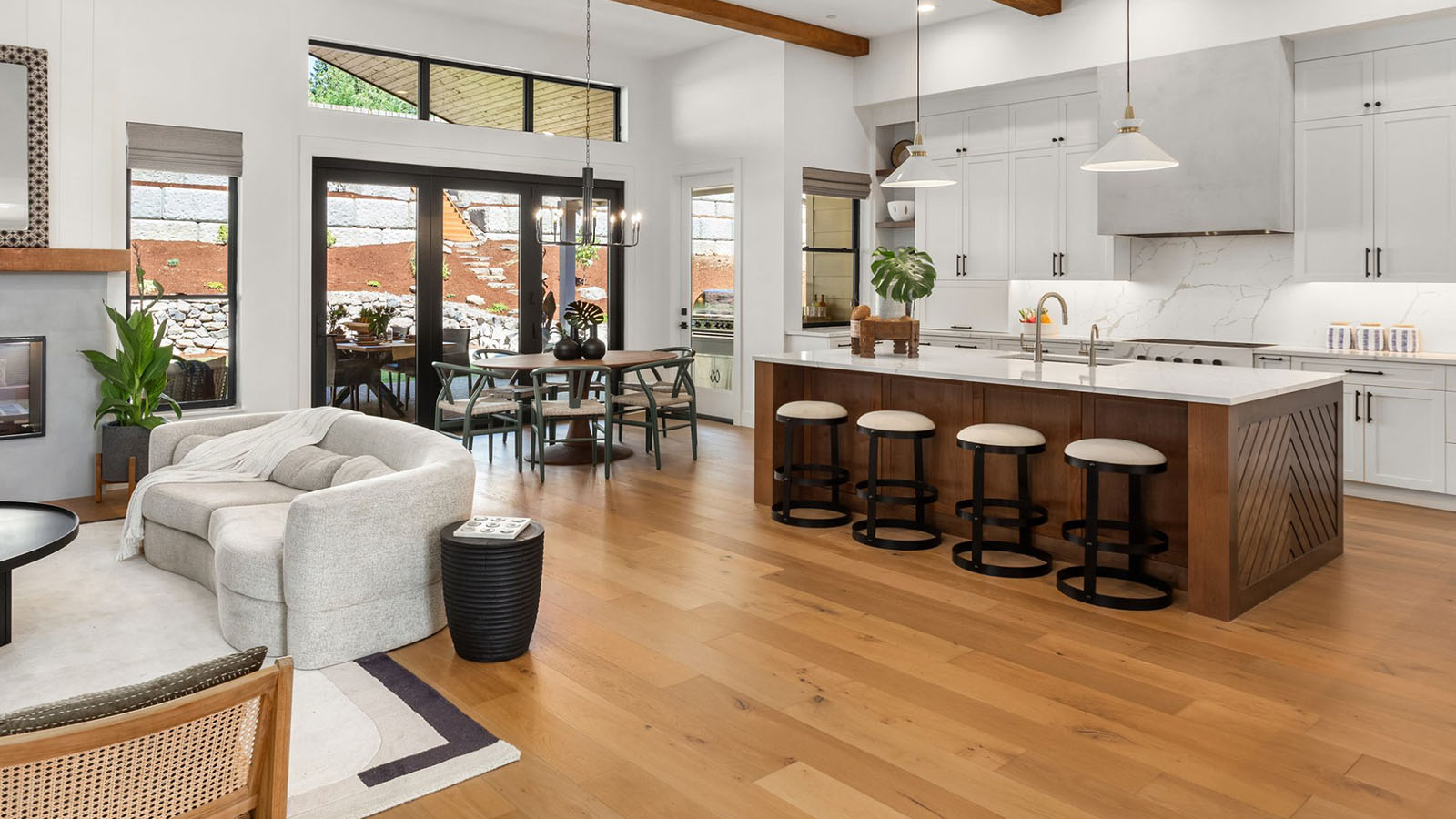
Affordable Kitchen Floor Replacements
Replacing your kitchen floor needn’t be a budget-breaking experience. Several affordable options are available that don’t skimp on quality or style. Doing it yourself can also significantly cut costs, although some materials, such as ceramic or porcelain tile and solid hardwood, are more complex to install.
DIY Installation
Certain types of flooring, such as engineered wood, vinyl planks and laminate, are particularly suited to DIY installation. These floors often use interlocking designs or floating floor methods, which can be relatively straightforward for the average handy homeowner.
Cheaper Alternatives to Tiles
If you like the look of tiles but find them too expensive, you might consider luxury vinyl tiles. These mimic the appearance of a stone tile or ceramic but are more affordable and easier to install.
Stained Concrete
Stained concrete is another affordable option. While it may not be everyone’s first choice for a kitchen floor, it can be extremely durable, low-maintenance and customizable to match various styles and color schemes.


Maintaining and Cleaning Your Kitchen Flooring
Opting for a durable and easy-to-clean flooring material can be a strategic choice that offers benefits beyond mere aesthetics. The benefits are twofold: not only does a hard-wearing floor withstand the rigors of daily kitchen activities, but it also minimizes the effort required for upkeep. This duality is a boon for any busy household, saving you valuable time and effort and making the kitchen a more enjoyable space to work and socialize.
The ideal kitchen flooring should exhibit resistance against common kitchen foes, such as stains and wear and tear. It should be hard enough to stand up against dropped utensils, spills and high foot traffic but also forgiving enough to make cleaning a breeze. A floor that meets these criteria supports a functional and low-maintenance kitchen, contributing to the overall ease and efficiency of your home life.
Vinyl Flooring
Vinyl flooring, including vinyl plank flooring and luxury vinyl tiles, is among the easiest to clean and maintain. This is due to their smooth surfaces and stain-resistant properties. They can be swept or vacuumed regularly and mopped with a damp mop.
Tile Flooring
Ceramic, granite tile and porcelain are also relatively easy to maintain. Regular sweeping and occasional mopping should keep them looking their best. However, grout lines may require extra attention to prevent staining.
Hardwood Flooring
Hardwood flooring, while beautiful, requires a bit more maintenance. This type of flooring should be swept or vacuumed regularly, and spills must be cleaned up promptly to prevent water damage. Using a wood cleaner periodically can also help maintain its finish.
Laminate Flooring
Laminate is stain-resistant and easy to clean, but it should be cleaned quickly, like all solid hardwood floors, to prevent water damage. A broom or vacuum for hardwood floors works best for regular cleaning.
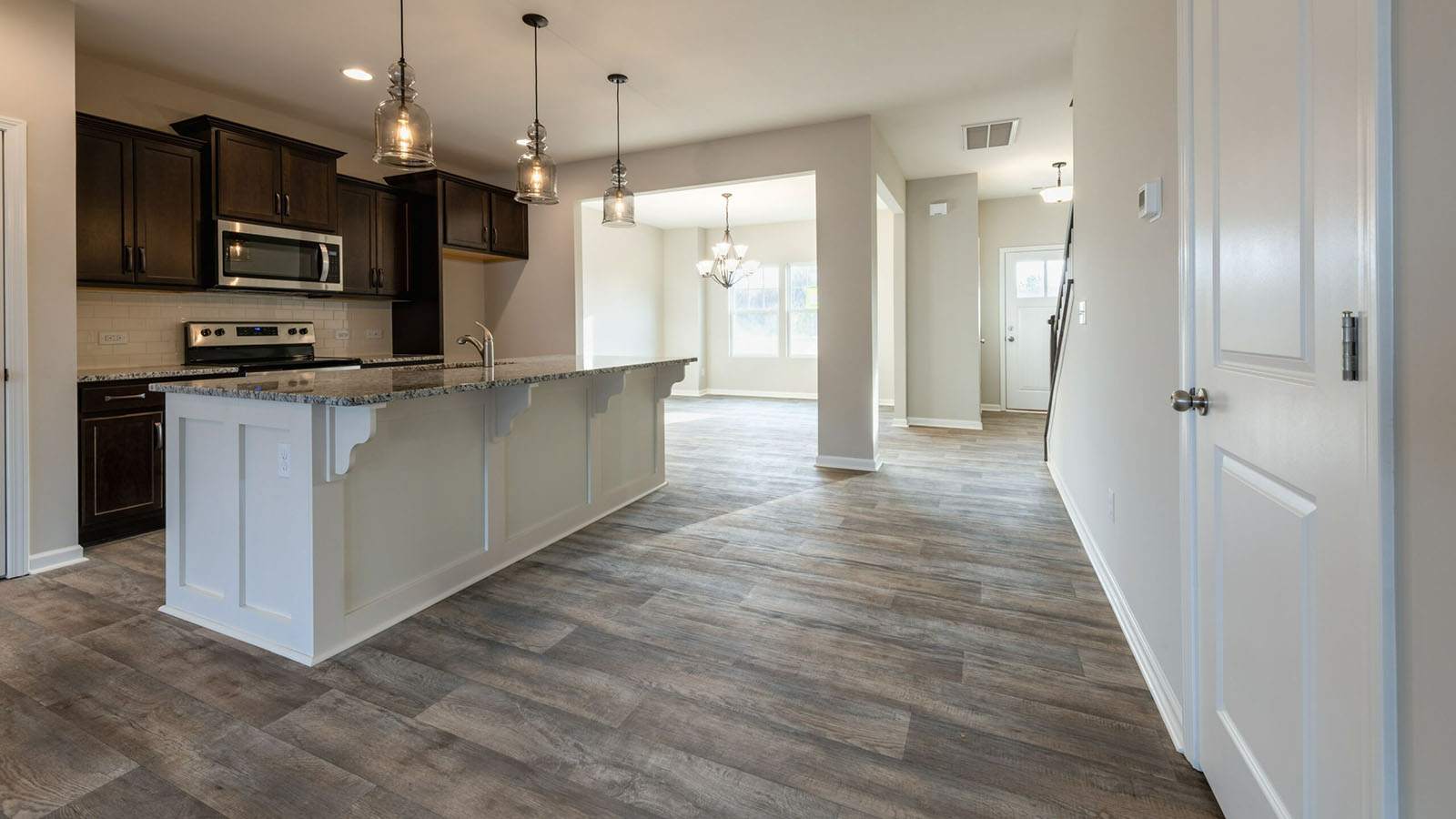
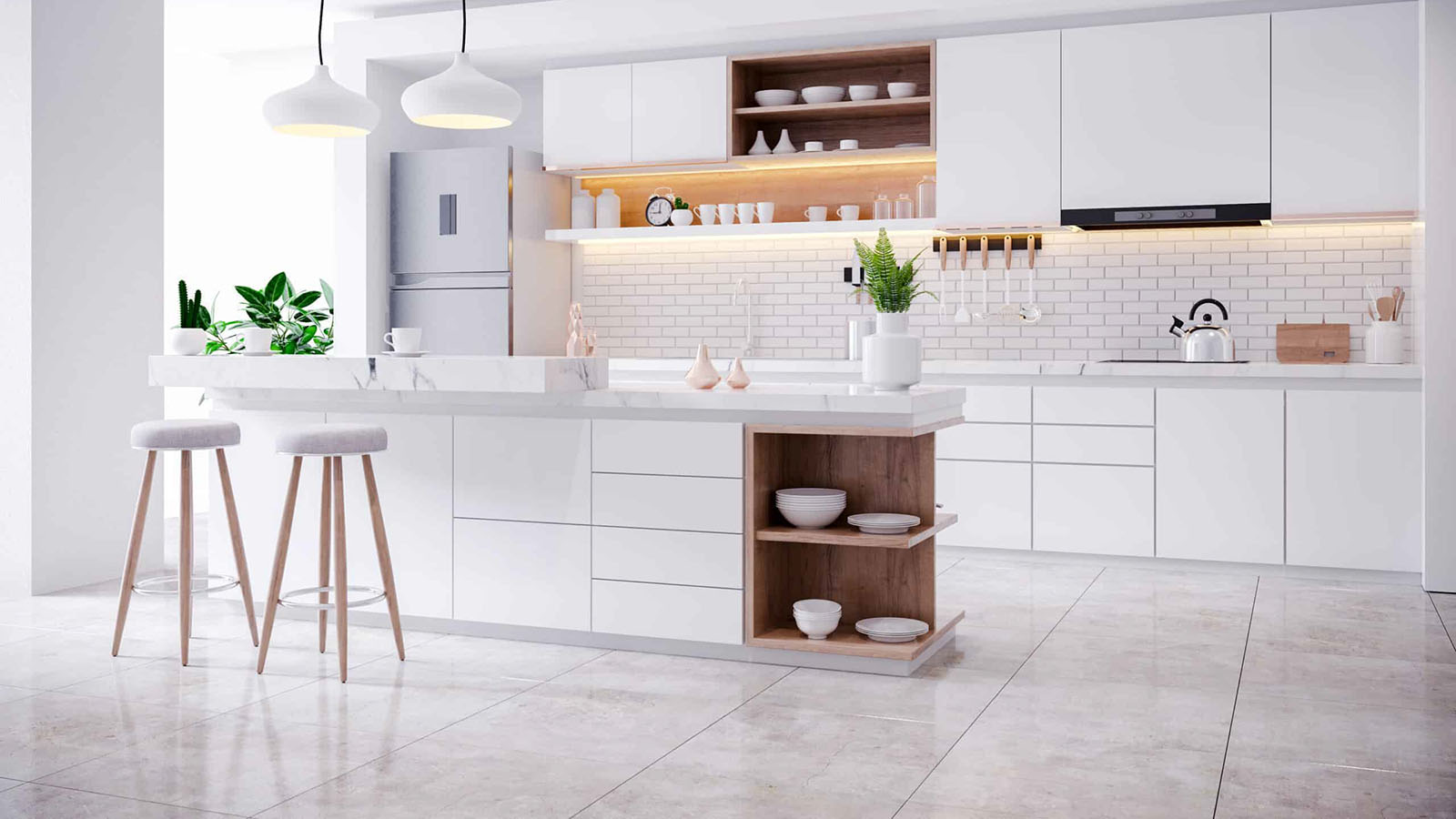
The Future of Kitchen Flooring
Today’s trends in flooring are evolving as homeowners’ demands and preferences shift towards materials that strike a perfect balance of durability, ease of maintenance and environmental sustainability. Not only are homeowners seeking materials that can withstand the wear and tear of daily use, but they also desire flooring that can be kept clean without much fuss or strenuous effort. This translates into a growing popularity for flooring options like luxury vinyl, bamboo and even polished concrete – all of which demonstrate impressive durability and low maintenance requirements.
Additionally, a product’s eco-friendliness significantly influences homeowners’ choices in our increasingly environmentally-conscious world. There’s a growing demand for sustainable and renewable flooring materials that leave a minimal carbon footprint. Bamboo and cork, for instance, are being chosen more frequently due to their regenerative properties and less harmful production processes. In essence, the trend in kitchen flooring is leaning towards an intersection of practicality, durability and respect for our planet’s resources, showcasing homeowners’ desires for a combination of functionality, aesthetics and eco-consciousness in their homes.
Sustainable Materials
Bamboo and cork flooring are increasingly popular for their sustainable qualities. Bamboo is a fast-growing plant that regenerates quickly, making it a renewable resource. Cork flooring is made from the bark of the cork oak tree, which naturally regenerates, making it a sustainable choice as well.
The Rising Popularity of Concrete Flooring
Concrete flooring is becoming more popular in modern and industrial kitchen designs. It’s extremely durable and can be customized to suit individual styles. It also has the benefit of being low-maintenance and long-lasting.
Luxury Vinyl Flooring
Luxury vinyl flooring, including luxury vinyl planks and tiles, is another trend to watch. These products offer the look of more expensive materials like hardwood and stone flooring kitchen but are more affordable and easier to maintain. They are also completely waterproof, making them a practical choice for kitchens.

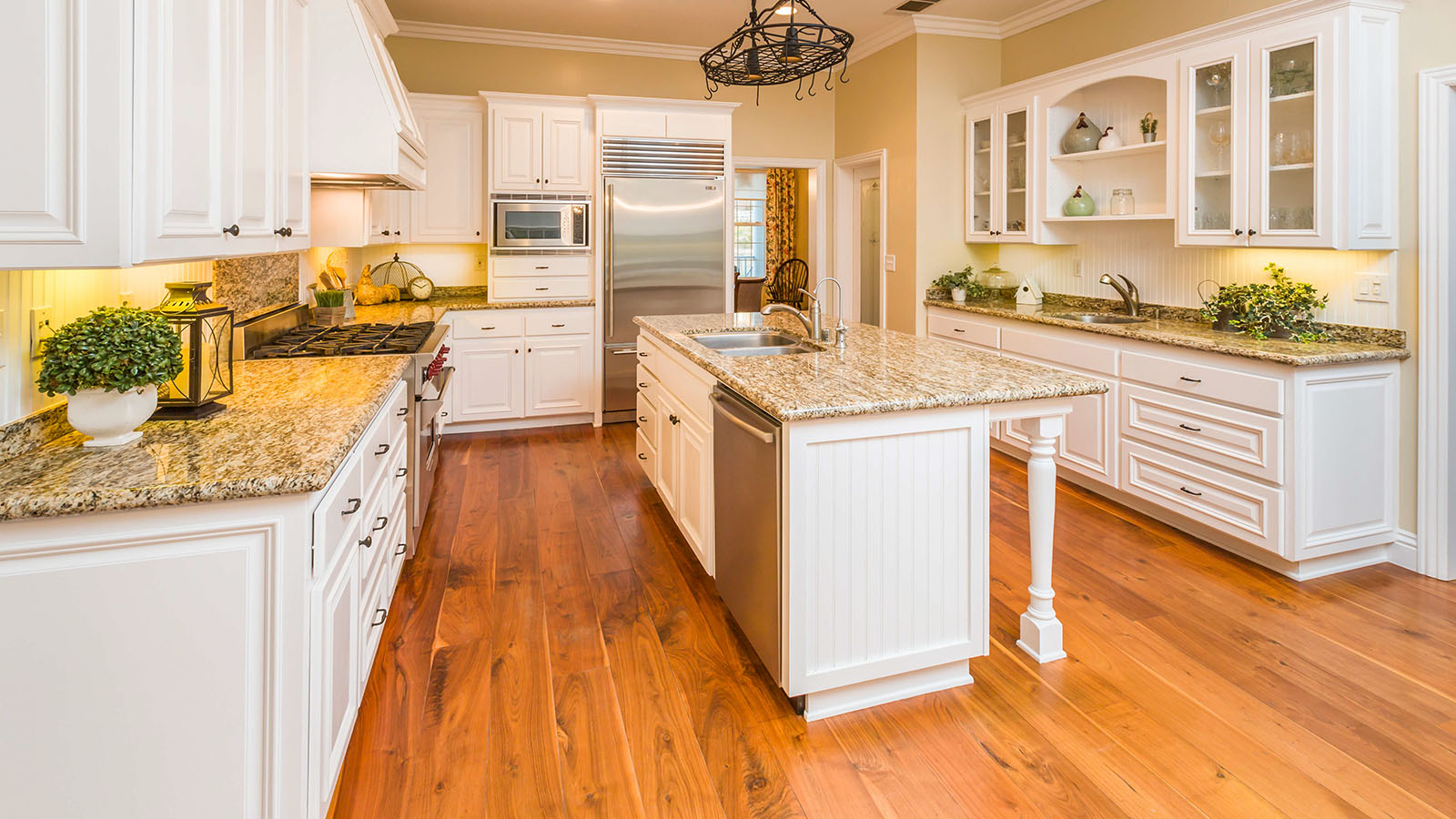
Choosing Your Ideal Kitchen Flooring
The quest to discover the best flooring for your kitchen is a personal journey shaped by various factors. These elements range from your budgetary constraints and stylistic inclinations to your lifestyle demands. Making the right choice involves grasping the pros and cons of each flooring type, such as per square foot cost, durability, aesthetics, and maintenance needs.
As a premier general contractor and remodeler in Northeast Ohio, we’re committed to facilitating this selection process for you. We stand ready to help you sift through the myriad of options, from the enduring beauty of hardwood to the practical resilience of luxury vinyl plank flooring or the affordability of sheet vinyl. Our expert guidance will aid you in making an informed decision that aligns with your needs and preferences, creating a kitchen you’ll delight in for years to come. Let us help turn your dream kitchen into a tangible reality, showcasing the perfect flooring option that complements your home’s unique charm.

